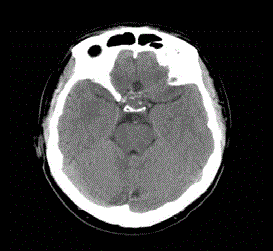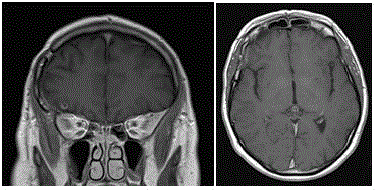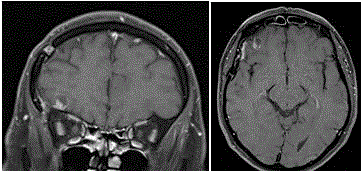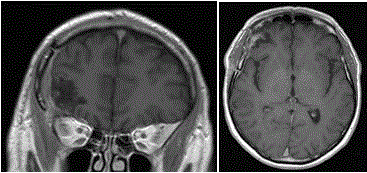Clinical Image
Ectopic Recurrence of Craniopharyngioma
Saeed F*, Anderson IA, Kamdar D and Ross S
Department of Neurosurgery, Leeds General Infirmary, Leeds, United Kingdom
*Corresponding author: Fozia Saeed, Department of Neurosurgery, Leeds General Infirmary, 629 Manor Mills Ingram Street, Leeds LS11 9BT, UK
Published: 19 May, 2017
Cite this article as: Saeed F, Anderson IA, Kamdar
D, Ross S. Ectopic Recurrence of
Craniopharyngioma. Clin Surg. 2017;
2: 1470.
Clinical Image
A 62-year-old, right-handed joiner, presented in 2006 with visual field disturbance. An MRI
head revealed a 4 cm × 2 cm solid and cystic mass in the suprasellar cistern, separate from the
pituitary gland; suggestive of a craniopharyngioma (Figure 1). The patient underwent pterional
craniotomy and excision of tumour. Post-operative recovery was unremarkable and final histology
results confirmed the diagnosis of craniopharyngioma.
Follow-up MRI scans revealed no evidence of residual disease and therefore, adjuvant
radiotherapy was not considered. However, a surveillance scan in 2012 revealed a 7 mm peripherally
enhancing extra-axial lesion in the right subfrontal region coincidentally close to the site of the right
pterional craniotomy (Figure 2). This was initially thought to be insignificant and was followed
up with yearly surveillance imaging. The lesion appeared to have cystic and solid enhancing
components and was, by 2015 felt certain to be increasing in size (Figure 3). Following MDT discussion, the progressive changes observed in the right frontal pole were felt most likely to represent a recurrent craniopharyngioma,
presumed seeded from the time of the original operation. The patient
was counselled and underwent exploratory craniotomy and excision
said subfrontal lesion. Histology confirmed diagnosis of recurrent
craniopharyngioma. Follow-up imaging at 3 months post resection
of recurrent craniopharyngioma demonstrated complete resection
(Figure 4).
Ectopic recurrent craniopharyngioma is a very uncommon
presentation [1-3]. There are currently only 18 reported cases in the
adult population [4]. Reported cases suggest that majority of them
occur within five years of surgery; similar to our patient [4]. The most
probable mechanism suggested is seeding along the surgical route
which would seem the most likely explanation in this case [5-9].
Figure 1
Figure 2
Figure 2
Post contrast MRI Head showing a peripherally enhancing right frontal extra-axial abnormality. A) T1
weighted gadolinium enhanced coronal image. B) T1 weighted gadolinium enhanced axial image.
Figure 3
Figure 3
Post contrast MRI Head showing a peripherally enhancing lesion with cystic components lying adjacent
to the prior right pterional craniotomy which has increased in size. A) T1 weighted gadolinium enhanced coronal
image. B) T1 weighted gadolinium enhanced axial image.
Figure 4
Figure 4
Post contrast MRI Head demonstrating complete resection of the
lesion. A) T1 weighted gadolinium enhanced coronal image. B) T1 weighted
gadolinium enhanced axial image.
References
- Elliott RE, Moshel YA, Wisoff JH. Surgical treatment of ectopic recurrence of craniopharyngioma. J Neurosurg Pediatr. 2009; 4: 105-112.
- Schmalisch K, Beschorner R, Psaras T, Honegger J. Postoperative intracranial seeding of craniopharyngiomas: Report of three cases and review of the literature. Acta Neurochir (Wien). 2010; 152: 313-319.
- Romani R, Niemelä M, Celik O, Isarakul P, Paetau A, Hernesniemi J. et al. Ectopic recurrence of craniopharyngioma along the surgical route: Case report and literature review. Acta Neurochir (Wien). 2010; 152: 297-302.
- Clark SW, Kenning TJ, Evans JJ. Recurrent ectopic craniopharyngioma in the sylvian fiddure thirty years after resection through a pterional approach: a case report and review of the literature. Nagoya J Med Science. 2015; 77: 297-306.
- Fuentes S, Metellus P, Dufour H, Do L, Grisoli F. Postoperative intracranial seeding of craniopharyngioma: three case reports and a review of the literature. Neurochirurgie. 2002; 48: 345-350.
- Barloon TJ, Yuh WT, Sato Y, Sickels WJ. Frontal lobe implantation of craniopharyngioma by repeated needle aspirations. AJNR Am J Neuroradiol. 1988; 9: 406-407.
- Israel ZH, Pomeranz S. Intracranial craniopharyngioma seeding following radical resection. Pediatr Neurosurg. 1995; 22: 210-213.
- Liu JM, Garonzik IM, Eberhart CG, Sampath P, Brem H. Ectopic recurrence of craniopharyngioma after an interhemispheric transcallosal approach: Case report. Neurosurgery. 2002; 50: 639-645.
- Jeong IH, Lee JK, Moon KS, Joo SP, Kwak HJ, Kim TS, et al. Ectopic recurrence of craniopharyngioma: a case report and review of the literature. J Neurooncol. 2006; 79: 191-195.




